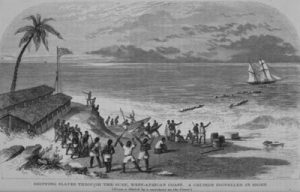Ebony Miree
ENG 302-Prof.Knappes
March. 10.18
Transition
“Being brought from Africa to America” by Phillis Wheatley reveals her story of transition. In the poem, Phillis Wheatley reveals her story of the geographic and psychological transition that she herself went through from being brought from her home land to a new place.In the digital archive “Captive Africans Taken to Slave Ship, Nigeria” is a landscape illustration that was drawn by a person who saw the slaves being put onto the ships and leaving for the New World. The connection between my archival object along with the poem by Phillis Wheatley is transition. The digital archive connects with the 18th century text by one of them starting off of a transatlantic voyage while the other talk about the completion of the journey. While the illustration presents itself as an object that gives its the viewer the feeling of being defeated the poem does the exact opposite by giving off a feeling of joy as well as strength. Both highlight the shift of a slave’s perspective of leaving a “free” life” in the past and trying to make sense of a “slave’s” life in the present.
My archival object is a landscape illustration which allows the viewer a chance to see the geographical location of the place. In the illustration you are able to see the slaves in the water but then the perspective fades away into the distance, as the slave ships become smaller. The illustration shows people being sold into slavery by their own people.In the picture it is clear to see who is whom, the seller has white clothes wrapped around them while the slaves have barely any cloth covering their bodies. The illustration depicts sadness along with loss because the slaves are being taken away from their native land. The illustration itself presents “transition” because they are being brought from Africa to a colonized land.
In her poem, Wheatley writes “Twas mercy brought me from my Pagan Land / Taught my benighted soul to understand.”(l.1-2). The poem picks up from where the illustration left off in terms of the theme of the trans-Atlantic voyage that slaves were forced to take. In the illustration there was sadness, loss, as well as hopelessness. The transition that happens here is that Wheatley shows how hopelessness turns into faith then sadness turns into happiness. Phillis Wheatley describes the transatlantic journey that she went through. Phyllis Wheatley suggests that even though she was kidnapped from her native land, she was given something greater in America: Christianity.Wheatley writes “That there is a God, that there’s a Saviour too.”(l.3-4) In the 1780’s, hymns were sung in order to give slaves hope, and Wheatley’s line shows the transition that many slaves made from Paganism to Christianity. The illustration of the African slave trade supports the narrative of the text transition because it is tells them “ Remember, Christians, Negros, black as Cain, May be refin’d, and join th’ angelic train”(“l.8) This is a message telling people who were slaves that there is soon going to be a transition that they are going to go through, they just have to stay strong. Looking at the archival object along with the poem they both display the topic of transition in terms of hardship.
Looking at the poem by Phillis Wheatley it is clear that the narrator in the poem saw that even though they were going through a the struggles of slavery in their life, they weren’t going to give up hope that their circumstances were going to get better. Phyllis Wheatley alludes that it doesn’t matter what race or religion that you are we have to rise above that so we can all be united, and her poem gives hope for those in the illustration who are embarking on the trans-Atlantic journey into slavery.
Works Cited Page
The Church Missionary Intelligencer. A Monthly Journal of Missionary Information (vol. 7 [1856], frontspiece, facing p. 241.

